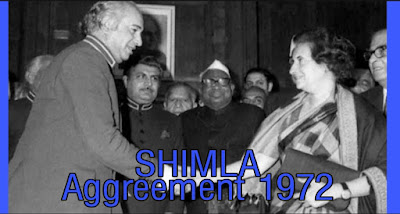What is the Shimla Agreement?
Under the Shimla Agreement, Pakistan diplomatically paved way for the recognition of the creation of Bangladesh. Under the Agreement, the ceasefire line established by the Karachi Agreement of 1948 was re-designated as the Line of Control (LoC).
Under the Shimla Agreement of 1972, as mentioned above, the ceasefire line was now renamed as the LoC and thereby the tenure of UNMOGIP to maintain peace on the ceasefire line came to an end.
 |
Indira Gandhi (Prime Minister of India) and Zulfiqar Ali Bhutto (President of Pakistan) |
The Simla Agreement of 1972 gave India an opportunity to put the conversion of the Kashmir issue from an international to a bilateral issue on paper. In 1972, under the Simla Agreement, Pakistan agreed to resolve Kashmir bilaterally without any third-party intervention. Though India gained at this point in 1972, however, critics point out that India lost an opportunity in 1972 to make the LoC as an international border. Due to a lack of clear demarcations, firing across the LoC continued from the Pakistani side in the 1980s, 1990s, and 2000s.
Rise of Terrorism in Kashmir
The Simla Agreement of 1972 could not solve all the problems and proved unable to stabilise Kashmir Since the 1950s, Sheikh Abdullah's National Conference (NC) was in power.
In the period from the 1950s to the 1980s, he was dismissed many times only to be appointed again.
In 1987, Kashmir held elections After the death of Sheikh Abdullah, Farooq Abdullah, his son, decided to form an alliance with the Congress for the elections.
In the 1980s, various social and religious organisations who wanted to resolve the Kashmir issue peacefully formed the Muslim United Front (MUF). The MUF too wanted to use the 1987 elections to put forth Kashmiri grievances peacefully at the legislative forum. Farooq Abdullah won the elections.
The MUF alleged that the elections were rigged, after which the MUF candidate Mohammad Yusuf Shah was imprisoned. This led to mass protests in the valley. A Pakistani militant outfit leader Syed Salahuddin too fuelled the protestors through his group, known as the Hizbul Mujahideen (HM), which had been originally founded by Muhammad Ahsan Dar.
The HM group mobilised Abdul Hamid Sheikh, Ashfaq Majeed Wani, Javed Ahmed Mir and Yasin Malik and formed the Jammu and Kashmir Liberation Front (JKLF). As the MUF cadres were suppressed, they began to cross over to Pakistan for support.
In 1979, the USSR had invaded Afghanistan. To contain the Soviets, the US began to take help from Pakistan. The CIA had provided arms, ammunition and money to the ISI to train Mujahideens to fight the Soviets and create an enormous amount of resistance to the Soviet rule in Afghanistan.



No comments
Post a Comment